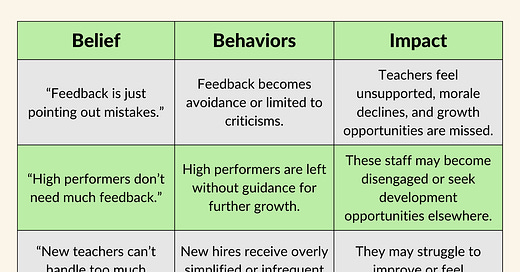Feedback is one of the most powerful tools for improving organizational performance, engagement, and innovation. Yet, misconceptions and limiting beliefs about feedback can prevent leaders from maximizing their potential.
Belief Inventory
Ok, let’s do a little activity. Are you ready? Go ahead and write it down.
1 = Strongly Disagree, 2 = Disagree, 3 = Neutral, 4 = Agree, 5 = Strongly Agree
Regular, meaningful feedback directly influences the motivation and performance of my team members.
Employees who receive feedback weekly are significantly more engaged than those who do not.
The type and frequency of feedback I provide differ for various subgroups of employees (e.g., high performers, struggling staff, new hires), and this impacts their engagement and growth.
Frequent feedback is a critical factor in retaining top talent in my school.
Feedback that focuses on future performance is more effective in driving improvement than feedback focused on past mistakes.
Feedback loops are essential in identifying and developing emerging leaders within my staff.
An open culture of feedback fosters greater creativity and adaptability in my school.
The way feedback is delivered (e.g., in-person, written, or via multimedia) significantly impacts its effectiveness.
Qualitative feedback is more effective than quantitative metrics in motivating staff and improving performance.
My feedback practices are free of unconscious bias and ensure equitable growth opportunities for all staff members.
Stay tuned! The Belief Inventory Research Guide is coming.
Example Belief Statement: "I believe feedback needs to be regular and meaningful. It is essential for fostering a high-performing and engaged team."
If a leader believes this, what would you imagine seeing them doing?
You might see them…
Scheduling regular one-on-one check-ins with team members to provide feedback.
Implementing tools like shared notes or feedback trackers to ensure feedback is given consistently.
Providing specific, actionable feedback, focusing on behaviors that can be replicated or improved.
Highlighting what employees are doing well before addressing areas of improvement.
Approaching feedback as a two-way conversation, asking questions like, “What specific improvements have you seen in participation during math guided practice?” or “What support would help you improve?”
Checking-in to see how changes are implemented and provide additional support as needed.
Beliefs drive action. So, what do you believe about feedback?
How Beliefs Shape Actions
Beliefs drive actions, especially when it comes to giving feedback. At first glance, providing feedback seems like a simple, straightforward leadership skill. Yet, so many of us avoid it. Why?
Because feedback feels awkward, it can feel confrontational, leaving us vulnerable to pushback. To justify avoiding it, we lean on our beliefs: “They’ll figure it out on their own,” “It’s not the right time,” or “Feedback will just make them defensive.” Whether consciously or subconsciously held, these beliefs shape our actions—or lack thereof.
Here are some examples of beliefs and the resulting impact:
Common Misconceptions About Feedback
Feedback is the same as criticism.
Reality: Feedback is future-focused and constructive, while criticism often looks backward and assigns blame.
Impact of Belief: A leader conflating the two may avoid giving feedback altogether, fearing negative reactions, which deprives staff of growth opportunities.
Feedback only happens during formal evaluations.
Reality: The most effective feedback is ongoing and informal, integrated into daily conversations.
Impact of Belief: Restricting feedback to formal settings can delay improvements and stifle engagement.
Systems for effective feedback will improve performance.
Reality: Different individuals and subgroups need varied types and frequencies of feedback.
Impact of Belief: A one-size-fits-all approach can alienate certain team members or fail to address their unique needs.
Practical Steps to Shift Your Beliefs
Reframe feedback as a tool for collaboration: Use inquisitive language to involve teachers in the problem-solving process.
Train yourself to focus on the future: Shift your language from “what went wrong” to “what can we do next time?”
Address biases directly: Reflect on who receives the most feedback and ensure equitable access to growth opportunities (Read: Why I am recruiting pissed-off teachers).
Conclusion
Feedback works (more on this soon). Yet, misconceptions and limiting beliefs about feedback can hold leaders back from unlocking their full potential.
Feedback doesn’t have to be uncomfortable or confrontational. When delivered with intention, it can be a collaborative, forward-focused process that strengthens trust, boosts performance, and fosters a culture of growth. But achieving this starts with your beliefs.
Take a moment to reflect:
Do you see feedback as an opportunity or a chore?
Are you holding back feedback out of fear, or are you leaning in to support your team?
Beliefs drive actions. If you want to improve your feedback practices, start by challenging the stories you tell yourself about feedback.








The thing I craved most at the lowest-performing schools I taught in was more feedback. I’ve found that the best teachers always want to have conversations about getting better!
And the best feedback sharpens both the giver and the receiver, promoting clarity and reflection…